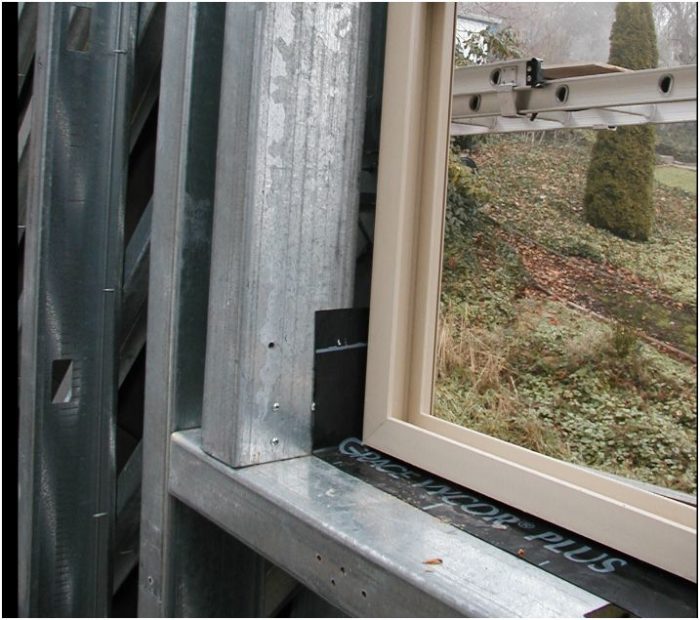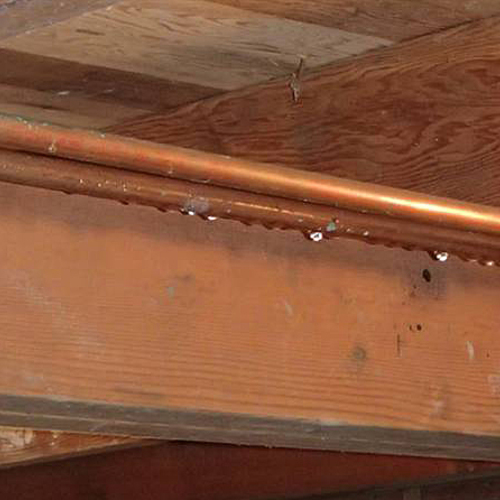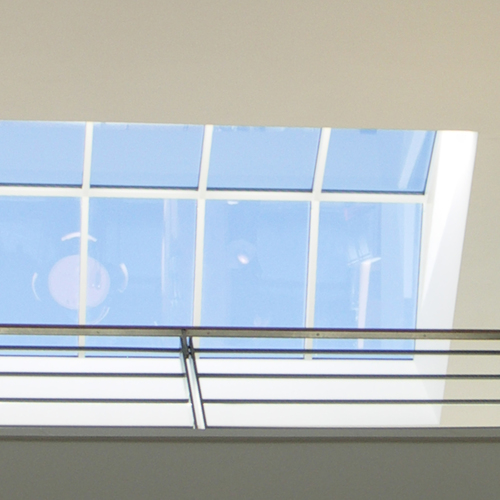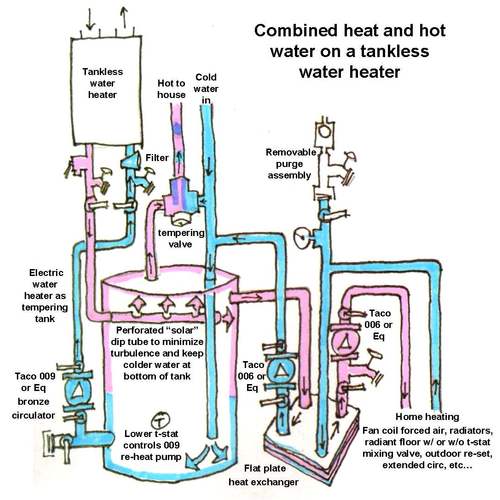Image Credit: Michael Anschel
Image Credit: Michael Anschel In addition to forming on the glass, ice also developed against the gaskets and in seams between the sash and the frame, even when they were sealed and locked.
Image Credit: Michael Anschel
Although I grew up in New York and attended college in New England, I have lived in the South for more than 30 years and have become physically acclimated to warmer weather and more accustomed to local building practices. My moderate-climate building experience is what leads me to speak up frequently about the fact that much of the information on GBA, as well as in the building science community as a whole, tends to be cold climate focused.
So it was with some trepidation that I ventured north to Minneapolis in January for a DOE Building America Retrofit Team meeting that I was invited to participate in as part of Verified Green. Having just experienced several days of cold weather and a region immobilized by a cover of ice, I checked the forecast for Minnesota and was not too pleased to learn that it was not projected to be much above zero for my entire visit. I dug out the few pieces of warm clothing I own, which, while reasonably effective at keeping me warm for short periods of time, would have likely led to my quick demise had I been stuck outside for more than an hour or two where I was going. But enough whining about the weather. I was happy to have an opportunity to spend time with my friends Michael Anschel and Chaden Halfhill, as well as Peter Yost, Gary Klein, Ted Cater from Panasonic, and other industry notables.
A great list
Pat Huelman of the University of Minnesota kicked off the DOE meeting with an overview of the project and a quick timeline of the evolution of green building, which succinctly described how each improvement led to problems that were solved by the next improvement:
1. Insulation, which taught us about air sealing;
2. Air sealing, which taught us about moisture;
3. Moisture control, which taught us about ventilation;
4. Ventilation, which taught us about combustion safety;
5. Combustion safety, so we don’t kill our clients.
I like his chronology, and I think it is probably repeated regularly by new entrants into high-performance construction—but it makes me wonder what the next items are on the list, because certainly we aren’t finished learning. Is worker safety the next one? What about product toxicity? Global warming potential? Who knows? But I think it will be interesting to see what’s next and when we figure it out.
Freezing windows
Probably the most interesting thing I experienced during my brief foray into the sub-arctic was the amount of ice on the interiors of windows and glass doors, even high-performance multi-paned units. We all know that windows are the weak links in most buildings, but the importance of this tends to be lost on many of us in moderate climates; as long as we limit excess solar gain, we are generally fine. What I learned about cold climates is that in very high-performance buildings with excellent insulation and air sealing, the difference between the overall performance of the window and the rest of the envelope is so extreme that a combination of air movement past the gaskets at window sashes and humidity in the air can cause condensation at the edges of the glass as well as at window hardware. And when it’s well below zero outside, that condensation quickly turns to ice. I am now beginning to understand why northern builders like super-high-performance windows, such as those available in Canada and Europe. When building envelopes are leaky and less well insulated, air and moisture can move back and forth by any path, reducing the amount of condensation and ice on windows. So we may have another unintended consequence to add to Pat’s list. Ultimately, the most important thing I learned from this experience was that I don’t want to live or work in extreme cold climates on a regular basis.
Temper, temper
One other cold-climate tidbit I picked up was the suggestion to install a tempering tank for incoming water before it is delivered to a water heater. Since municipal water supplies in the North can sometimes be only slightly above freezing, it was suggested that installing an un-insulated storage tank in the basement to store water before it is heated is a good energy-saving strategy. The tank will allow water to rise from the incoming temperature to the ambient basement temperature—often as much as a 30-degree rise—requiring much less energy to heat the water to 110 degrees in the heater. Sounds like a cool (or warm) idea, but, according to Mr. Anschel, these tanks are not readily available, so plumbers end up buying cheap water heaters and stripping off the insulation and heating elements. Now that sounds kind of strange to me.
Regarding all these cold-climate issues I have raised, I realize that humans are quite adaptable and I would likely become accustomed to cold-climate weather (and construction methods) after a few weeks or months, and I might even begin to appreciate shorter, milder summers. I do think, however, that I’ll stay where I am for the time being. If I decide to move, I’m pretty sure it will be to another moderate climate—most likely not one like Minnesota’s, at least not for the winter. Brrrrr.
Weekly Newsletter
Get building science and energy efficiency advice, plus special offers, in your inbox.
















16 Comments
sme diff, no?
What's the diff between heating the water in the storage tank, or heating it in the water heater? Same energy, no? Is this about letting the boiler cycle less often, perhaps? I missed something, I guess. Glad you got to experience the cold first hand, too; that rounds a person out, they say.... j
Water heat
The tempering tank heats the water to the temperature of the ambient air in the basement just by being in the semi-conditioned space before it goes to the water heater. Adds about 30+ degrees to the water temperature, reducing the amount of energy required to heat it to 110 or 120. Just learned about it, seems like a good, simple idea.
Tempering incoming water
Carl,
If you are tempering incoming water, you are robbing space heat from your home. You won't save any energy, but you may save dollars -- but only if you use a different (cheaper) fuel for space heat than for heating domestic hot water.
High-performance window?
Carl,
We need more information on the windows in the photos -- windows which you call "high-performance" windows.
Triple glazing or double glazing? Casements or double-hungs? Wood, vinyl, or fiberglass frames?
Here in Vermont, a high-performance window is a fiberglass-framed triple-glazed casement or awning window. I'm guessing your photo shows a double-glazed double-hung window -- of course I may be wrong -- which would explain the frost.
Preemptive answers...
Thanks Martin, that's what I was wondering.
I was also going to ask about the windows...
Water and Windows
Martin, I don't disagree with you, just reporting on what cold climate people are talking about. I think the concept is that in a semi conditioned basement, transferring a small fraction of the ambient heat to incoming cold water will have little effect on the overall temperature in the house while reducing the amount of energy required to heat up the water in a tank or tankless unit.
On the windows, I believe the ones in the photos are double glazed wood casements, some of them may have a removable interior energy panel. I will confirm this and report back.
I think the energy savings
I think the energy savings come if you have GSHP or newer gas furance. You areachieving 80+ efficiency from the furnace. Unless you have a new super efficient water heater your in the 50-60% effieciency range. Another benefit would be on recovery rates.
I wonder how a on-demand water heater would do with water temps in the 30's?
Response to Robert Hronek
Robert,
I have an Aquastar on-demand gas water heater, and I have used it with 35°F incoming water. It works.
Manufacturers of on-demand water heaters publish specs showing the maximum flow (in gallons per minute) for different temperature rises. Of course, it takes more energy to raise the temperature of the incoming water 100° than to raise the temperature 50°.
Deep Window Sills
I've read that keeping the window sash as close to the inside face of the wall as possible can help reduce the amount of ice since the convective currents that can get warm air to the glass aren't compromised by deeper sills. Unfortunately, of course, this is contrary to keeping window units (and their sashes...) to the outer face of the wall where they are more readily integrated with the drainage plane....
Doesn't it take a tremendous amount of energy to heat 40 gallons of water 30 degrees?...
Tempering tank
I like your 'great list' which demonstrates how changing one thing leads to a new impact - to wit:
An uninsulated tempering tank like the one you describe will sweat like crazy here during a Minnesota summer. Most incoming water lines have to be insulated or we risk damage to finished basements.
A frequently flushed basement toilet often needs the tank insulated too.
not following the 'tempering' tank logic
it seems like it relies on the old wise tails guidance
yes, a tempering tank will warm extremely cold water as it enters the building - well, it will warm some of it depending on hot water use. the tank warms so slowly that peak usage periods will see little warming as the entering water will quckly exit before any warmth is gained unless the tank is big
BUT the tempering tank must steal its energy from somewhere, and if the tank is inside any sort of building envelope, then it is stealing from another internal source. i'm not seeing the net gain, especially considering the additional costs
i guess you could argue that the tempering tank is stealing heat that was just going to go out the building envelope anyway; seems like it would be stealing more heat more quickly than normal exfiltration of air, which means the main building has to leak more heat to make up the difference. that part is beyond my abilities to calculate
the ultimate solution would be a traditonal hot water tank with insulation, surrounded by a bonded second tank of exterior tempering water, or surrounded by a long circumferential tempering pipe which would pick its heat up from that which escapes the tank, something like how a drain waste heat pipe is modeled.
this reminds me of the advice of placing a hot food item on the counter to cool before putting it inside of the fridge, to reduce the cooling the fridge needs to do. of course if its summer and you are air conditioning your home, you are still paying to cool that dish while it sits on the counter; in the winter, its free heat!
stealing heat for a pre-heat source
I think people are missing some important points. For many of us here in the frozen north (Maine for me) we have concrete basements (or granite stone). These floors and walls are HUGE heat sinks and mostly below the frost line (smart ones spray foam on the part above the outside ground level. A bare tank of cold water will certainly soak up some heat (that's the whole idea) but that heat is likely to come from the heat sink -- and it is capable of "heating" thousands of gallons of water without really affecting ambient temperatures (it can get replacement heat from the surrounding dirt). How do I know? Well, I recently installed an Air-Source Heat Pump cold water heater (why do they call them hot water heaters? We don't need to heat hot water. I digress...) This unit is effectively a reverse air conditioner. It steals heat from the air and squeezes it into the water. The by-product is cold air pressed into the basement. In my 48 x24 basement it cools the air about 3-4 degrees (after it's run for awhile) but it's only temporary. The walls and floor soak it up in short order and the ambient temp returns to what it was. I expressed concern to an engineer at GE about this (he was on the development team) and he assured me their testing showed that this wouldn't happen if the area was at least 10 x 10 x 8. Adding a 40 - 80 gallon 'pre-heat' bare tank would have substantially less effects than my heater. Thinking it will steal heat from the heated envelope (in my case anyway) I believe is a red herring.
However that said: Condensation in summer would be a severe problem. Very severe. We have high humidity in summer and cold water pipes and tanks sweat like a roofer pouring hot tar in the noon-day sun. To keep basements somewhat dry we are forced to insulate cold water pipes and tanks. It's a fairly serious issue. Having a bare 40-80 tank of cold water would become a source of bulk water! No can do.
As a note: My air source water heater has a hose to collect condensate from the squashing of the air. It's only been installed since November but to date I have collected less than 1 cup of water. I'm expecting that in the summer I'll have a source of some good clean water on a continuing basis. Stand by.
Another note: Air Source Heat Pump Water Heaters are not cheap ($1400?) but, the electric meter used to spin at high speed with the old electric water heater. Now it turns at a lazy crawl. Very lazy. I can't yet reliably determine the cost savings but I'm sure they'll pay for the new heater. And meanwhile I've cut my impact on the planet. It's worth it.
stealing heat for a pre-heat source
I think people are missing some important points. For many of us here in the frozen north (Maine for me) we have concrete basements (or granite stone). These floors and walls are HUGE heat sinks and mostly below the frost line (smart ones spray foam on the part above the outside ground level. A bare tank of cold water will certainly soak up some heat (that's the whole idea) but that heat is likely to come from the heat sink -- and it is capable of "heating" thousands of gallons of water without really affecting ambient temperatures (it can get replacement heat from the surrounding dirt). How do I know? Well, I recently installed an Air-Source Heat Pump cold water heater (why do they call them hot water heaters? We don't need to heat hot water. I digress...) This unit is effectively a reverse air conditioner. It steals heat from the air and squeezes it into the water. The by-product is cold air pressed into the basement. In my 48 x24 basement it cools the air about 3-4 degrees (after it's run for awhile) but it's only temporary. The walls and floor soak it up in short order and the ambient temp returns to what it was. I expressed concern to an engineer at GE about this (he was on the development team) and he assured me their testing showed that this wouldn't happen if the area was at least 10 x 10 x 8. Adding a 40 - 80 gallon 'pre-heat' bare tank would have substantially less effects than my heater. Thinking it will steal heat from the heated envelope (in my case anyway) I believe is a red herring.
However that said: Condensation in summer would be a severe problem. Very severe. We have high humidity in summer and cold water pipes and tanks sweat like a roofer pouring hot tar in the noon-day sun. To keep basements somewhat dry we are forced to insulate cold water pipes and tanks. It's a fairly serious issue. Having a bare 40-80 tank of cold water would become a source of bulk water! No can do.
As a note: My air source water heater has a hose to collect condensate from the squashing of the air. It's only been installed since November but to date I have collected less than 1 cup of water. I'm expecting that in the summer I'll have a source of some good clean water on a continuing basis. Stand by.
Another note: Air Source Heat Pump Water Heaters are not cheap ($1400?) but, the electric meter used to spin at high speed with the old electric water heater. Now it turns at a lazy crawl. Very lazy. I can't yet reliably determine the cost savings but I'm sure they'll pay for the new heater. And meanwhile I've cut my impact on the planet. It's worth it.
Points of interest
You are all missing the hilariousness of watch Carl walk half a block in Mpls with a stocking cap, gloves, sweater, and heavy jacket; shivering and saying "What the f$*k is wrong with you people!"
Tempering tanks are quite common, especially with geothermal systems, and are not 'robbing' the home of heat. As Martin knows, air has poor storage capacity compared to water. Want to improve the efficiency of your refrigerator? Keep it full. Putting a 100 gallon storage tank in the basement isn't going to create an energy penalty for the home, since the water would require heating regardless, and it reduces the amount of wasted energy from the highly inneficient (40%) water heaters that occupy most homes.
The window in question is a fixed window. Architect series from Pella. There is more to the story though. While the low-e insulated glass of the fixed windows and casement windows all failed, the triple pane windows elsewhere in the house also failed.. but not at the glass. The rest of the windows all failed in the frames, sash to sash connections, and sash to jamb connections. If you want to have an interesting discussion, you can talk about how window manufacturers believe that if the RH in a home exceeds 25% when it is -15 outside, that the failure is not their concern. That, energy friends, is a serious problem.
Response to Michael Anschel
Michael,
A BTU is a BTU. If you're raising the temperature of a tank of water in your home, it's going to take the same number of BTUs to raise the water temperature no matter how you do it. Of course you can use the space heating system to raise the water temperature by putting a big uninsulated tank in your house.
As I wrote earlier, such an approach won't save energy, but it may save dollars -- if your water heater is less efficient or uses a more expensive energy source than your space heating system.
Dirk Faegre seems to think that a basement tempering tank will extract heat from the soil near his basement wall without using any BTUs from his space heating system. Count me a skeptic. First of all, basement walls should be insulated -- limiting the amount of heat you'll be able to get from your soil. Secondly, during the winter most basements are warmer than the soil on the other side of the foundation, so the flow of heat is outward, not inward. Although the amount of heat required may not be obvious to Dick or Michael, heat is heat, and it generally isn't free.
Response to Michael Anschel
"If you want to have an interesting discussion, you can talk about how window manufacturers believe that if the RH in a home exceeds 25% when it is -15 outside, that the failure is not their concern. That, energy friends, is a serious problem."
Firstly, I'll admit out of the gate I am a window manufacturer/distributor. Wait, don't shoot!
Secondly, if your window supplier is using terms like "not their concern", I'd find a new one.
The real issue IS the humidity in the home relative to the exterior temp and the condensation point is dependent mostly upon the u-value of the window but air flow in the home will greatly impact this. Michael, I'm guessing you build a fairly tight home and have low ACHs. As we as an industry continue to ratchet down on air sealing (thanksfully!) this will become even more previlent. Put simply, it's science. It's not "crappy windows" or "crappy installation" as both sides seem to like to use as an excuse at times. The main thing here is if you have a true window professional they'll provide you with the information you need to make everyone's client happy. If condensation is occuring sometimes simply putting a fan in the room will move enough air to move that moisture so it doesn't condense. I hope the document I attached is helpful Michael.
You mention the "failure" here, Are you referring to condensation on the glass as the issue or is the issue the "failure" throughout on these units? Can you please explain in detail what failed exactly on these Pella's? Sash to sash connection? I'm confused and honestly, on the edge of my seat to hear this nightmare.
Log in or create an account to post a comment.
Sign up Log in